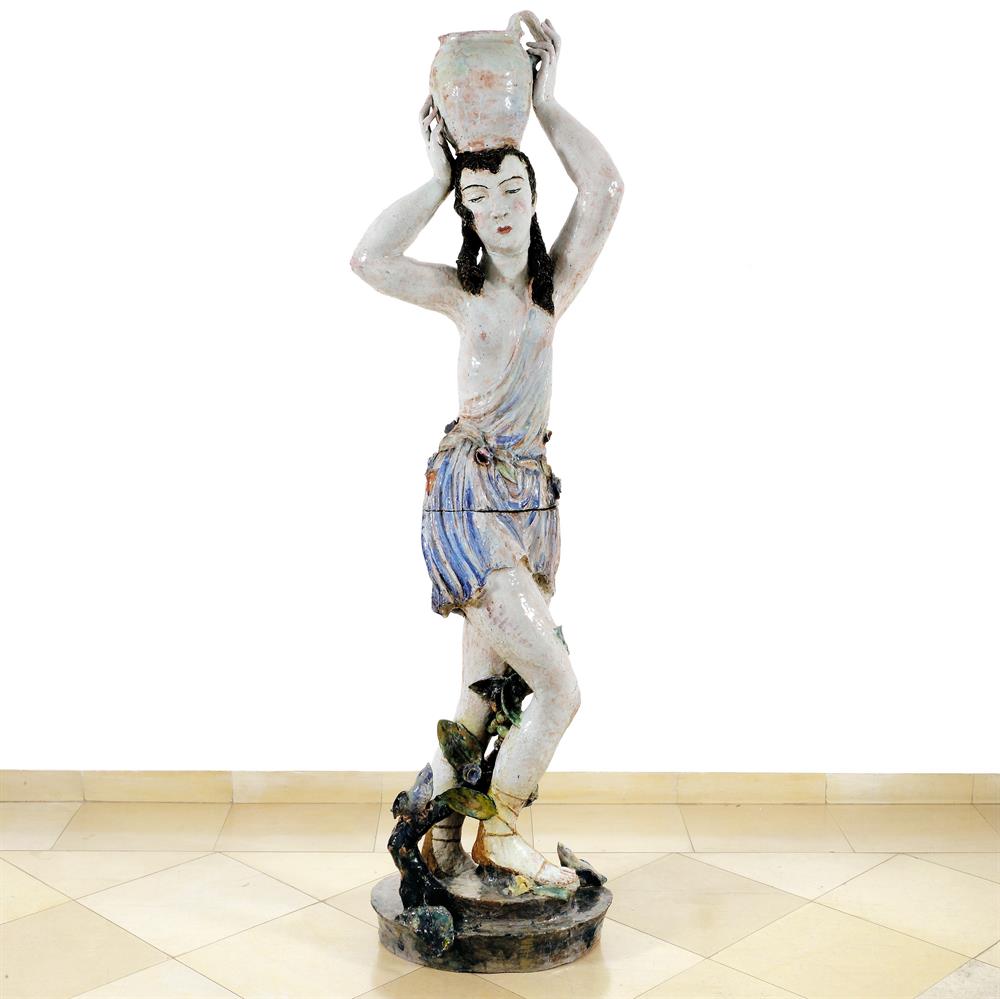
Vienna 1891 - 1955 California
Figure with Jug
Unique pieceManufactured by the Wiener Werkstätte, Model number KO 5489
Red pottery, polychrome glaze
H 170.8 cm, W 50.8 cm, D 33 cm
Mark: WW
Signed: Singer
Professionally restored
Ausstellungen:
New York, Wiener Werkstätte Showroom, 1923
Vienna, MAK, „Die Frauen der Wiener Werkstätte“, 2021
Vienna, Jüdisches Museum, "Love Me, Kosher. Liebe und Sexualität im Judentum", 2022
Sweden, Millesgarden Museum, "Wiener Werkstätte", 2024/2025
Literatur:
WW-Archive, MAK Vienna, design sketch KI 13017-1, Photo-Archives WWF 108-42-1
cf. L.W. Rochowanski, Wiener Keramik, Leipzig and Vienna 1923, ill. p. 157
cf. Die Wiener Werkstätte 1903-1928. Modernes Kunstgewerbe und sein Weg, Vienna 1929, ill. [n.p.]
cf. Waltraud Neuwirth, Die Keramik der Wiener Werkstätte. vol. I: Originalkeramiken 1920-1931, Vienna 1981, ill. p. 145, no KO 5489 (design sketch)
Werner J. Schweiger, Wiener Werkstaette. Kunst und Handwerk. 1903-1932, Vienna 1982, ill. p. 115 (Sales catalogue of the Wiener Werkstätte)
cf. Exhibition catalogue „Der Preis der Schönheit – Die Wiener Werkstätte und das Palais Stoclet“, ed. by Peter Noever, MAK, Vienna 2006, ill. p. 312
Exhibition catalogue, Wiener Werkstätte 1903-1932. The Luxury of Beauty“, ed. by Christian Witt-Dörring and Janis Staggs, Neue Galerie, New York 2017-18, ill. p. 526, no 23
Exhibition catalogue „Die Frauen der Wiener Werkstätte“, ed. by Christoph Thun-Hohenstein, Anne-Katrin Rossberg, Elisabeth Schmuttermeier, MAK, Vienna 2021, ill. p. 174, no 21
Exhibition catalogue "Love Me, Kosher. Liebe und Sexualität im Judentum", Jüdisches Museum, Vienna 2022, ill. p. 29
Susi Singer’s figures are of gothic fragility and immateriality. They always move gracefully along an imaginary S-curve, as if following the rhythm of a gentle melody. Susi Singer worked with clay like a sculpture, and transformed the soft, malleable material into signs that design space, always complemented by a highly nuanced and fanciful glazing.
Her figures are – very much in the tradition of rococo – merry narratives of daily life, of fairy tales and stories, yet also finely observed character studies. The nearly two-metre high sculpture presented here, ‘Figure with Jug’, was selected in 1922 for the new Wiener Werkstätte branch in New York, which was run by the architect and designer Joseph
Urban until 1924. In 1923 he presented the figure prominently in the magazine ‘Modern Interiors’, which he founded. Moreover, in his role as Art Director of the Cosmopolitan Film Productions owned by the billionaire William Randolph Hearst, he deliberately inserted Wiener Werkstätte products in the film sets, such as Susi Singer’s ‘Figure with
Jug’, which could be seen as a prominent background motif in a scene in the most successful silent movie of 1923, ‘Enemies of Women’.1 The figure was shown in 2022 as part of the exhibition ‘Love Me Kosher’ at the Jewish Museum Vienna.
1 Exhibition catalogue ‘Wiener Werkstätte 1903–1932. The Luxury of Beauty’, ed. by Christian Witt-Dörring and Janis Staggs, Neue Galerie, New York 2017/18, ill. p. 526, no. 23
